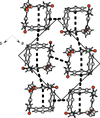issue contents
August 2023 issue

Cover illustration: Three new Schiff bases derived from 3-formylacetylacetone and benzyl-, tert-butyl- and (S)-methylbenzylamine have been synthesized and structurally characterized. They exist as enamine tautomers that contain nearly planar amino-methylene-pentane-2,4-dione cores. The main structural differences between the compounds arise from conformational aspects regarding the orientation of the CH2Ph, CH(CH3)Ph and C(CH3)3 moieties. In order to obtain some insight into how the observed conformations are influenced by the crystal packing, the gas-phase molecular structures of these compounds were optimized by DFT methods. See: Halz, Hentsch, Wagner & Merzweiler [Acta Cryst. (2023). E78, 707–713].
research communications



































 journal menu
journal menu





































